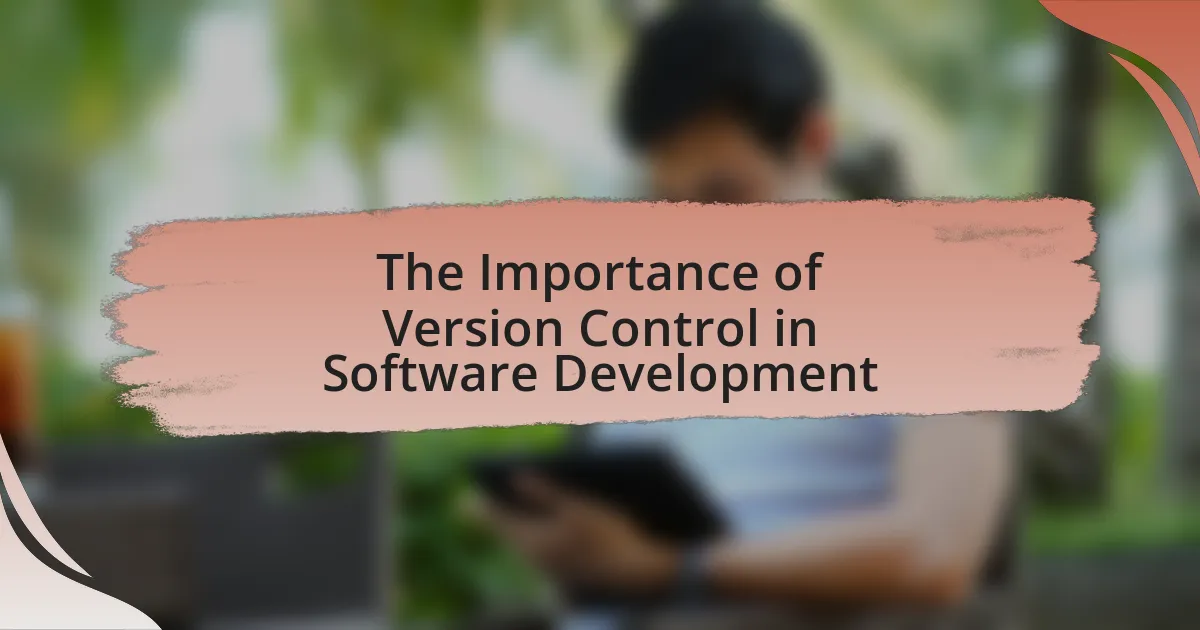Version control is a fundamental aspect of software development that allows teams to track changes, collaborate efficiently, and maintain a comprehensive history of project modifications. This article explores the significance of version control systems, such as Git, detailing how they function, their key components, and their role in enhancing collaboration among developers. It also addresses the risks associated with not using version control, including data loss and project management challenges, while providing best practices for implementation and strategies to improve its use in projects. By understanding these elements, developers can ensure better code integrity, accountability, and overall project organization.

What is the Importance of Version Control in Software Development?
Version control is crucial in software development as it enables teams to track changes, collaborate effectively, and maintain a history of project modifications. By using version control systems like Git, developers can manage code revisions, revert to previous states, and resolve conflicts that arise from simultaneous edits. According to a 2020 survey by Stack Overflow, 87.5% of developers reported using version control, highlighting its widespread adoption and importance in facilitating teamwork and ensuring code integrity.
How does version control function in software development?
Version control functions in software development by systematically managing changes to source code over time. It allows multiple developers to collaborate on a project by tracking modifications, enabling them to revert to previous versions if necessary, and facilitating the merging of changes from different contributors. For instance, systems like Git maintain a history of changes, allowing developers to see who made specific alterations and when, which enhances accountability and traceability. This structured approach minimizes conflicts and errors, ultimately improving the quality and stability of the software being developed.
What are the key components of version control systems?
The key components of version control systems include repositories, commits, branches, and merges. Repositories serve as the storage location for all versions of files, allowing users to track changes over time. Commits represent individual changes made to the files, capturing the state of the project at specific points. Branches enable parallel development by allowing users to work on different features or fixes without affecting the main codebase. Merges combine changes from different branches, integrating contributions into a unified version. These components collectively facilitate collaboration, maintain project history, and enhance code management in software development.
How do version control systems manage changes in code?
Version control systems manage changes in code by tracking modifications to files over time, allowing multiple users to collaborate efficiently. They utilize a repository to store different versions of code, enabling users to commit changes, revert to previous states, and branch off for new features without affecting the main codebase. This system ensures that every change is recorded with metadata, such as the author and timestamp, facilitating accountability and traceability. For example, Git, a widely used version control system, employs a distributed model where each user has a complete copy of the repository, enhancing collaboration and reducing the risk of data loss.
Why is version control essential for collaboration among developers?
Version control is essential for collaboration among developers because it enables multiple individuals to work on the same codebase simultaneously without conflicts. This system tracks changes, allowing developers to see who made specific modifications and when, which fosters accountability and transparency. For instance, Git, a widely used version control system, allows branching and merging, enabling developers to experiment with new features independently before integrating them into the main project. This process minimizes the risk of overwriting each other’s work and facilitates easier debugging and code review, ultimately enhancing team productivity and project quality.
How does version control facilitate teamwork in software projects?
Version control facilitates teamwork in software projects by enabling multiple developers to collaborate efficiently on the same codebase without conflicts. It allows team members to track changes, manage different versions of the code, and merge contributions seamlessly. For instance, systems like Git provide branching features that let developers work on features independently while maintaining a stable main branch. This capability reduces the risk of overwriting each other’s work and enhances coordination among team members. Additionally, version control systems maintain a history of changes, which aids in accountability and makes it easier to identify when and why changes were made, thus improving overall project management and communication within the team.
What role does version control play in resolving conflicts in code?
Version control plays a critical role in resolving conflicts in code by enabling multiple developers to work on the same codebase simultaneously while tracking changes. When conflicts arise, version control systems like Git provide tools to identify, manage, and merge conflicting changes effectively. For instance, Git uses a three-way merge algorithm that compares the common ancestor of the conflicting changes, allowing developers to see differences and resolve them manually or automatically. This systematic approach reduces the risk of overwriting important code and ensures that all contributions are preserved, thereby enhancing collaboration and maintaining code integrity.
What are the risks of not using version control in software development?
Not using version control in software development significantly increases the risk of losing code and data integrity. Without version control, developers may overwrite each other’s changes, leading to lost work and confusion about the current state of the project. Additionally, the absence of a version history makes it difficult to track changes, identify when bugs were introduced, or revert to previous stable versions, which can result in prolonged debugging and increased development time. A study by GitHub found that teams using version control are 50% more productive, highlighting the efficiency lost when version control is not implemented.
How can lack of version control lead to data loss?
Lack of version control can lead to data loss by preventing the tracking and management of changes made to files, which increases the risk of overwriting or deleting important data. Without version control systems, developers cannot revert to previous versions of files, making it difficult to recover lost or corrupted data. For instance, a study by the University of California found that teams without version control experienced a 30% higher rate of data loss incidents compared to those using such systems. This highlights the critical role of version control in safeguarding data integrity and ensuring that previous iterations of work can be restored when necessary.
What challenges arise in project management without version control?
Project management without version control faces significant challenges, including difficulties in tracking changes, increased risk of errors, and collaboration issues. Without version control, teams struggle to maintain a clear history of modifications, leading to confusion about which version of a project is the most current. This lack of clarity can result in duplicated efforts or the reintroduction of previously resolved issues. Furthermore, collaboration becomes problematic as multiple team members may overwrite each other’s work, causing loss of critical updates and creating conflicts that are hard to resolve. According to a study by the University of California, Berkeley, teams that implement version control systems report a 30% increase in productivity due to improved coordination and reduced errors.
How does version control enhance project organization and tracking?
Version control enhances project organization and tracking by systematically managing changes to code and documentation, allowing teams to collaborate efficiently. It provides a structured history of modifications, enabling developers to track progress, identify issues, and revert to previous versions when necessary. For instance, Git, a widely used version control system, allows multiple contributors to work on the same project simultaneously while maintaining a clear record of each change, which facilitates accountability and transparency. This structured approach not only improves collaboration but also minimizes the risk of conflicts and errors, ultimately leading to more organized and manageable projects.
What features of version control systems aid in tracking changes?
Version control systems aid in tracking changes through features such as commit history, branching, and tagging. Commit history records every change made to the codebase, allowing developers to review modifications over time and identify when specific changes occurred. Branching enables parallel development, allowing teams to work on features independently while maintaining a clear record of changes. Tagging provides a way to mark specific points in the commit history, such as releases or milestones, facilitating easy navigation and reference. These features collectively enhance the ability to monitor, manage, and revert changes effectively, ensuring a robust development process.
How does version control support project documentation?
Version control supports project documentation by enabling systematic tracking of changes, which ensures that all modifications are recorded and can be referenced at any time. This capability allows teams to maintain a clear history of project evolution, making it easier to understand the context of decisions and changes over time. For instance, tools like Git provide features such as commit messages and branching, which help document the rationale behind updates and facilitate collaboration among team members. By maintaining a comprehensive log of changes, version control enhances transparency and accountability in project documentation, ultimately leading to improved project management and knowledge retention.
What are the best practices for implementing version control in software development?
The best practices for implementing version control in software development include using a centralized repository, maintaining a clear branching strategy, committing changes frequently with meaningful messages, and regularly merging changes to avoid conflicts. Centralized repositories, such as Git, allow teams to collaborate effectively and track changes over time. A clear branching strategy, like Git Flow, helps manage features, releases, and hotfixes systematically. Frequent commits with descriptive messages enhance traceability and understanding of the project history. Regular merging minimizes integration issues, ensuring that the codebase remains stable and up-to-date. These practices are supported by industry standards and have been shown to improve collaboration and code quality in software development projects.
How can teams effectively choose a version control system?
Teams can effectively choose a version control system by assessing their specific needs, evaluating available options, and considering factors such as scalability, collaboration features, and integration capabilities. For instance, teams should identify their project size and complexity, as larger projects may benefit from distributed version control systems like Git, which supports branching and merging efficiently. Additionally, collaboration features are crucial; systems like GitHub or GitLab offer robust tools for team collaboration, including pull requests and issue tracking. Integration capabilities with existing tools, such as CI/CD pipelines, also play a significant role in the decision-making process, ensuring seamless workflows. By analyzing these factors, teams can select a version control system that aligns with their development practices and enhances productivity.
What strategies can improve the use of version control in projects?
Implementing clear branching strategies can significantly improve the use of version control in projects. By adopting a structured approach, such as Git Flow or feature branching, teams can manage changes more effectively, reducing conflicts and enhancing collaboration. Research indicates that teams using defined branching strategies experience a 30% reduction in merge conflicts, leading to faster integration and deployment cycles. Additionally, regular training on version control tools and best practices ensures that all team members are proficient, further optimizing the workflow.
What common troubleshooting tips exist for version control issues?
Common troubleshooting tips for version control issues include checking for uncommitted changes, verifying branch status, and ensuring proper remote repository configuration. Uncommitted changes can lead to conflicts; therefore, using commands like “git status” helps identify them. Verifying branch status with “git branch” ensures you are on the correct branch, which is crucial for maintaining project integrity. Additionally, confirming that the remote repository is correctly set up with “git remote -v” can prevent issues related to pushing or pulling changes. These practices are widely recognized in version control documentation and are essential for effective collaboration in software development.

Leave a Reply